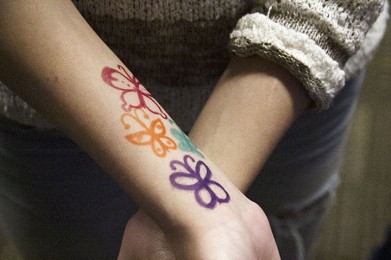Editor’s Note
In this issue of the “The Tiger Print,” the main feature story, beginning on page 23, addresses a sensitive
subject — self-harm and depression. To respect the privacy of the students interviewed, we have left out their names and grade levels.
We would also like to acknowledge that this story and the photos may be a trigger for some readers. Please read at your own discretion.
If you or anyone you know is struggling with depression or self-harm, here are numbers to call in order to talk to someone for advice and help:
BV Safe Schools Hotline: 239-4357
Suicide Hotline: 1-800 273-8255
“I can feel my heart pounding rapidly in my chest.
My hands are shaking and pulling at my hair.
My mind is clouded as so many thoughts swarm my head.
I scrunch my eyes closed.
Everything is moving in slow motion.
I know my family is asleep and unaware.
I feel the blade slowly drag across my wrist.
My wrist softly stings, but I continue, soon feeling no pain.
My thoughts are empty.
I feel at ease as I delicately draw the lines over my skin, watching my pain release.
I reach for a towel to stop the bleeding.
The blood rushes out, staining the towel and falling into my white sink.
I look in the mirror.
Another mistake.
I see a sad girl, crying, with bleeding wrists.
Her eyes look lost and empty with mascara running down her tear-stained cheeks.
She feels alone, lost, disappointed and frustrated.
She stands there holding a bloody razor blade.
Her tears fall onto her wrists as she realizes what she has just done.”
— A first-hand story from the viewpoint of an anonymous source
According to teenhelp.com, 20 percent of teens will experience depression before reaching adulthood.
This Blue Valley student began feeling depressed her sophomore year.
“I didn’t have very many close friends — I haven’t really had a stable friend group — and I just started feeling [depressed],” she said. “I didn’t know quite why. Then, I started figuring it out more when I was a junior.”
Another BV student described what depression felt like to him.
“It’s this feeling of intense sadness that you can’t shake,” he said. “It’s a weight bearing down on you that exhausts you and slowly sucks away all your happiness — your hopes, dreams, desires and motivation. It feels like a deep hole where there’s no light, and you’re just stuck watching everyone live happy lives. [This makes] you feel worse about yourself. You start to believe everything about you is wrong and can’t see any of the good in life.”
The first student mentioned she used cutting around three times a week as a way to cope with her depression.
While she was never actually diagnosed with depression, she said it runs in her family.
“There was a point where I just couldn’t take it anymore,” she said. “It was almost like I just wanted to feel something.”
She said she did not necessarily have a thought process while self-harming.
“I didn’t really have [a plan],” she said. “One day, I just kind of did it, and it kind of numbed what I was feeling — or at least that’s what it felt like to me. That’s probably why I continued doing it. I felt calmer after doing it. Normally, I’d be inconsolably crying, and then right after, I’d get very calm. I’d feel a lot better than I had before.”
She said there were many reasons behind her depression and self-harm.
“I think it was just a bunch of little things that combined to a point in which I could not take it anymore,” she said. “I was stressed. I was cyberbullied. I was sexually harassed — I’ve been bullied most of my life. I don’t have very many friends.”
She said she decided not to seek counseling in order to deal with her depression.
“Other people in my family have gone [to counseling] before, and it has not gone well,” she said. “So, I didn’t really want to go. [Not seeking therapy] probably isn’t the best option — and I definitely wouldn’t recommend it to anyone — but I just wanted to prove to myself that I was strong enough to get out of it by myself.”
She said the main form of self-harm she used was cutting — however, there are other forms of self-harm people use.
“There are other ways you can self-harm, and I would consider just not believing in yourself enough to be self-harming as well,” she said. “Like, just looking in the mirror at yourself and thinking, ‘You’re stupid. You’re worthless.’ That, too, is self-harming because you’re self-harming the image you have of yourself.”
She said she acts on impulse when she self-harms.
“I don’t really think about it much when I do it,” she said. “It doesn’t really feel like much of anything because I’m in such a frenzy in my head that I’m focused on that instead of what is actually going on.”
She said stress plays a large part in her depression.
“When I’m stressed, I’m unable to deal with my stress, and the stress just makes your breaking point a lot lower,” she said.
She said her parents still don’t know about her self-harm.
“I think a lot of my friends know because they knew I was going through a lot,” she said. “They just kind of figured it out eventually.”
She said she still has some of the scars — however, she said it has been a long time since she’s self-harmed.
“They go away after a really long time,” she said. “I look at them, and, sometimes, I’m like, ‘This is who I was, and I don’t want to be that person again.’ It’s like a reminder of what I don’t want to do. Then, sometimes, when I look at them, and I’m having a bad day, I’ll just feel sort of disappointed in myself, too. So, it’s a mix of being disappointed and being stronger now than I was back then.”
She said finding outlets other than self-harm helped her stop the act of self-harming.
“It was almost starting to scare me because I was thinking of doing even more,” she said. “So, I figured I needed to try and find better outlets. I got really involved in music — I started playing the piano a lot, dancing, singing — just trying to find things that distracted me if I was feeling upset. Also, writing helped a lot because with writing, I was able to release feelings I was otherwise doing with self-harm.”
She said she is doing better now that she has positive outlets to release her emotions.
“I still have down days,” she said. “I think having outlets to release bad energy is definitely a lot better. I just try to stay really positive as much as I can.”
She gave her advice to other people contemplating self-harm.
“Don’t do it,” she said. “Don’t use that as an outlet, especially because it does get to a point where it can be extremely addictive. There are a lot of other outlets you can use. Also, you really should get help if you need it. You can honestly talk to anyone, and they will help you.”
She said she has contemplated suicide, but she has never actually attempted to take her life.
“I’ve definitely had suicidal thoughts before — quite a few of them, probably,” she said. “I just couldn’t go through with it. Part of the reason for that involves my faith. Another part of it was that I feel like God only gives you what you can handle, and he never gives you more. What he gives you is to make you appreciate the things you have.”
Q&A with Child and Youth Mental Health Initiative Courtney Ryan
Question: What is your job title?
Answer: “I’m the director of the Child and Youth Mental Health Initiative, and the main component of my program is depression and suicide prevention presentations for teenagers in high school.”
Q: How do you handle a call regarding suicide?
A: “We only have a warmline. A warmline is different from a hotline in that it is for people that are maybe depressed or lonely — don’t have anyone to talk to — and it’s just a way for them to talk, basically. We have many volunteers who just listen and offer empathy and advice. If there is a crisis situation where someone is contemplating suicide, we get a hold of the national suicide prevention hotline. Locally, those calls go through Lawrence. We just connect them to that and stay on the line with them until they get connected to someone who can coach them through that.”
Q: What should someone do if they are feeling depressed or suicidal?
A: “If it’s suicidal thoughts, it is most important to reach out for help. I understand that’s not always the easiest thing to do, especially if someone is feeling that way, but they can go to their friends first. If your friend is acting that way, then you really need to listen to them without judgment and show empathy towards them. It’s also always important to talk to a trusted adult because if someone needs professional help, adults can help them get there. If it’s depression or self-injury, I think developing coping mechanisms is important, and that’s not something that is difficult to do — it’s just things that you enjoy that will make you happier and can help you deal with things. It could be exercise — it could be meditating. Just anything you do for fun, those can be coping skills. However, you can’t use negative coping skills like substance abuse or self-injury.”
Q: How can someone help their friend get through depression?
A: “Listening to them without judgment is very important — and actively listening to them, not just kind of passively listening to them, but being empathetic when you listen to them. You also need to keep a close eye on them if they are showing any warning signs of suicide. It is really important to step in at that point and get help from an adult. And if you’re worried about them being mad at you, keep in mind that it is only temporary. That is more important than them losing their life.”
Q: What are warning signs of suicide?
A: “If they were talking about death. If they were talking about being worthless or helpless, even if they’re joking and saying things like ‘I wish I was dead’ or ‘I should just kill myself,’ even if it’s just as a joke, it can be a [warning] sign of suicide. Kind of acting recklessly. Also, an increase in substance abuse can be a sign.”
Q: What types of topics do you discuss when you speak at high schools?
A: “I start out talking about the signs and symptoms of depression. I want to make sure everyone understands what depression is before we start talking about suicide — also, what can cause depression. We talk about how often suicide occurs in the United States among youth. We talk about some of the myths about suicide. I also show a brief video about a girl from Kansas City, and she is a suicide-attempt survivor, so she shares her story, and we talk about that.”
Q: What is the best part about your job?
A: “Some of the best things [I’ve encountered] have been students coming up to me after my presentations and telling me their own personal struggles with mental illnesses or depression and, sometimes, even suicide attempts. Once, I did receive a letter from a girl a couple weeks later thanking me for giving her the courage to get help. I’ve been able to talk with some kids afterward, and I also know that some have reached out and gotten help afterward, so that’s been really great.”





